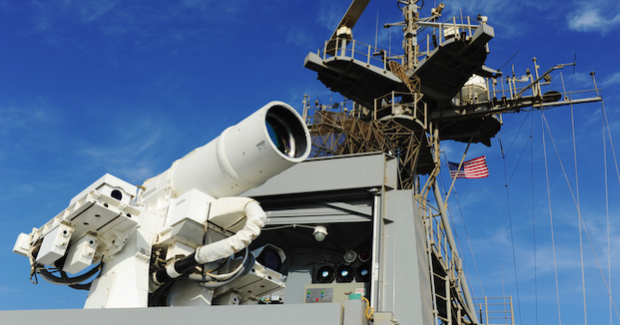Laser Weapons: Surgical Precision or Cutting-Edge Liability?

Laser weapons are beginning to be seriously considered in US defence forces planning. After a slow start, they may soon begin appearing as part of conventional platforms—from ships to B-52s. But there remain some logistical challenges, and the risks are still being calculated.
US Air Force Chief Scientist Greg Zacharias went on the record in early February about a research program called SHIELD—a five-year research effort that aims to retrofit B-52s with laser weapons. “You can take out the target if you put the laser on the attacking weapon for a long enough period of time,” Zacharias told Scout Warrior in an exclusive interview.
Across the Atlantic, the UK Ministry of Defence announced a partnership with company Dragonfire in January this year. In a £30 million (AU$48.54 million) contract, they aim to create laser weapons systems (LaWS) for maritime and land environments that can be rolled out in the mid-2020s. Prototype demonstrations are due to begin in 2019.
These are not long-term timeframes and LaWS seem to be an inevitable part of modern military platforms. The USS Ponce has been equipped with a 30 kilowatt (kW) laser since 2014 and there is video online featuring its capabilities against close-in maritime and airborne targets.
Cost and effect
The 30kW laser cost US$40 million (AU$52.30 million) to develop and deploy, however it only costs around US$0.59 to fire. That’s somewhat cheaper than the US$115,000 to US$1.5 million a single missile can cost. As Rear Admiral Matthew L. Klunder said in 2014, “With affordability a serious concern for our defence budgets, this will more effectively manage resources to ensure our sailors and marines are never in a fair fight.”
In January at the annual Surface Naval Association symposium, Rear Admiral Ronald Boxall—director of the Surface Warfare Division—confirmed the US Navy’s plans to fire a 150kW laser off a surface ship this year. “Then a year later, we’ll have that on a carrier, a destroyer or both.”
Now a 150kW LaWS is powerful, but to fire it requires 450kW. That’s a lot of energy and importantly, more energy than most surface ships can generate while supporting their normal activities. This means that ships equipped with 150kW LaWS will need substantial energy magazines—imagine three cabinets of batteries that can hold 930kW at full power for about three minutes.
Increasing the risk factor
Moving away from the logistical issues of having to redo the power management of surface ships, there are deeper concerns that arise with LaWS. Namely, the fact they fire at the speed of light which inevitably speeds up the process of acquiring, selecting and engaging targets. High levels of automation aren’t so much a problem with close-in weapons systems—they’ve been heavily automated for a long time—but it may become a problem if the LaWS are deployed on autonomous systems.
Maintaining the balance of human decision making within autonomous decision loops is only going to get more difficult as those loops speed up. Where humans once flew individual drones, they can now fly swarms. If each drone in that swarm were to field a close-in defensive LaWS then the ability of one operator to maintain primacy over the decision making hierarchy would be stretched.
Protocol IV to the Convention on Conventional Weapons—the Protocol on Blinding Laser Weapons—presents yet another significant liability. The 1995 protocol bans laser weapons designed with blinding as a specific combat function. Though Article 3 of that protocol quite explicitly states that blinding as an incidental or collateral effect is not covered by the prohibition, a combatant or civilian permanently disabled through collateral damage would be a publicity disaster.
Such an event is extremely unlikely but it’s not impossible and with the proliferation of LaWS the likelihood is only going to increase. The likelihood is further compounded by the autonomous decision making systems necessary to make the weapons respond effectively in combat situations.
Futuristic arms race
BAE Systems is exploring a Laser Developed Atmospheric Lens concept, which among other things could be used as a deflector shield to protect aircraft, land vehicles, troops and ships from LaWS. This begs the obvious—but hypothetical—question of where a laser goes when it’s deflected.
While it may be dubious to pose such a hypothetical question now, lasers specifically designed to ‘dazzle’ are already in use. Causing temporary blindness may not be in direct contravention of Protocol IV, but something bright enough to dazzle at a distance can blind at close range.
The potential applications for LaWS are immense and they may stand to save militaries vast sums of money in the long term. However, like all new weapons classifications, it’s important to ask if we really need it. The answer might be that LaWS are necessary because of the efficiency and precision they bring to targeting. Regardless, it’s worth exploring whether these weapons need to be on the battlefield.
Thom Dixon is a councillor with AIIA NSW and a young leader with the Pacific Forum CSIS’s Young Leaders Program. He works as project officer in the office of the deputy vice-chancellor at Macquarie University.
This article is published under a Creative Commons Licence and may be republished with attribution.





